Indoor Soccer for Kids – Young Champions
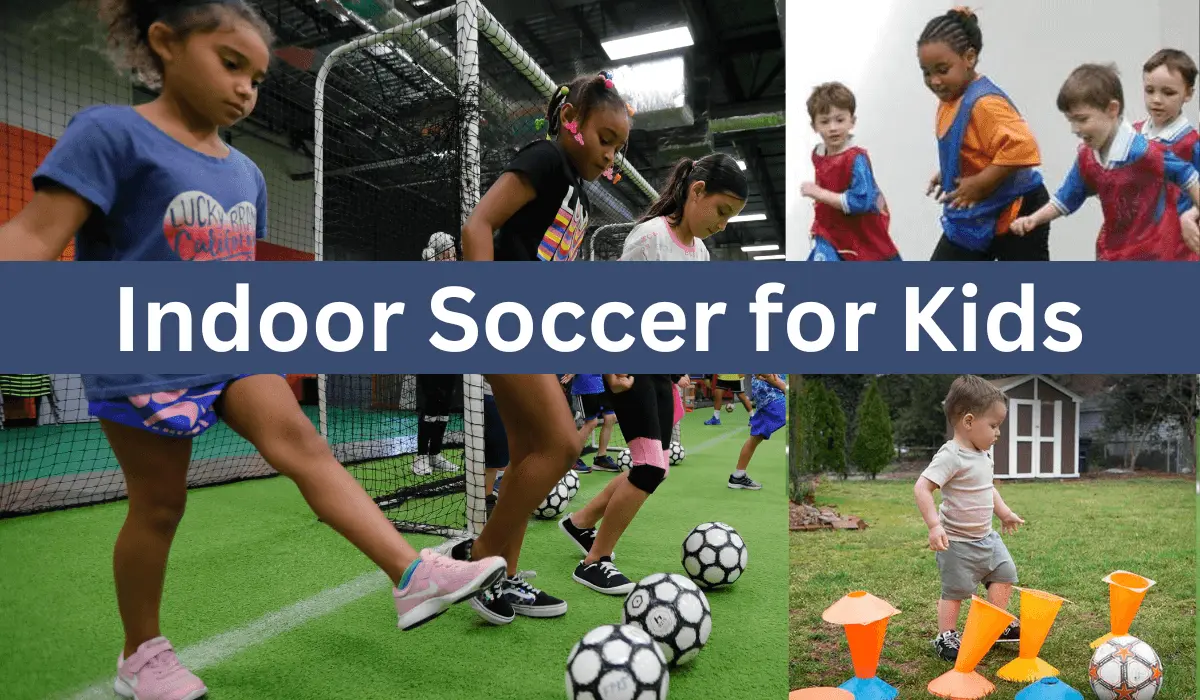
School gyms morph into vibrant mini-pitches, echoing with the joyous shouts of kids chasing dreams with a ball at their feet. Indoor soccer’s rising popularity is more than just a trend; it’s a gateway for young athletes to unleash their potential, both on and off the court.
Sure, the enclosed court, dasher boards, and lightning-fast gameplay offer an electrifying twist on the beautiful game. But what truly sets indoor soccer apart are its multidimensional benefits for kids:
Physical Prowess
Indoor soccer is a fitness bonanza! Every sprint, dribble, and pass builds agility, coordination, and endurance. Think Messi’s lightning footwork translated to a smaller stage, fostering healthy habits and a love for physical activity.
Social Butterfly
Teamwork takes center stage here. Kids learn to communicate, collaborate, and strategize as a team, forging friendships that extend beyond the final whistle. Imagine the high fives and cheers after a winning goal, building self-confidence and camaraderie that last a lifetime.
Cognitive Champs
Quick thinking is key! Indoor soccer challenges kids to adapt, make decisions on the fly, and solve problems under pressure. It’s like a mental boot camp disguised as fun, sharpening focus, memory, and decision-making skills.
Life Lessons Academy
From sportsmanship to perseverance, indoor soccer teaches valuable life lessons. Kids learn to win with grace, handle losses with resilience, and respect their opponents. It’s a training ground for characters, preparing them for challenges beyond the pitch.
Important Points of Indoor Soccer for KidsBenefits of Indoor Soccer for Kids
Develops fitness, agility, coordination
Find child-friendly indoor facility
Inspiring, caring coaches
Dynamic warm-ups & gentle cooldowns
Encourage passion for soccer |
But unlocking this potential requires more than just kicking a ball around. To maximize the indoor soccer experience for kids, consider these tips:
- Find the Right Fit: Choose a facility equipped for kids, with age-appropriate balls, goals, and safety measures. Think local rec centers or specialized indoor soccer arenas like Sports Blast or United Futsal.
- Cater to Their Level: No mini-Messi needs to feel overwhelmed. Match the intensity and complexity of the game to each child’s age and skill level, ensuring fun and growth for everyone.
- Make it Fun and Engaging: Ditch monotonous drills for exciting games and imaginative challenges. Think of dribbling obstacle courses, mini-tournaments with friends, or even themed games inspired by their favorite soccer stars.
- Safety First: Proper equipment, like shin guards and cleats, is crucial. Ensure the facility prioritizes hygiene and sanitization to prevent injuries and illnesses.
- Parents as Cheerleaders: Support goes a long way! Encourage your child, celebrate their victories, and help them learn from setbacks. Remember, your positive presence can ignite their passion for the game.
The indoor soccer experience is more than just a sport; it’s a catalyst for growth, a builder of character, and a creator of lifelong memories. So, lace up your kids’ shoes, find the perfect pitch, and watch them blossom as they kick their way into a world of fun, friendship, and valuable life lessons. Indoor soccer, with its boundless potential, awaits!
Pros of Indoor Soccer for Kids
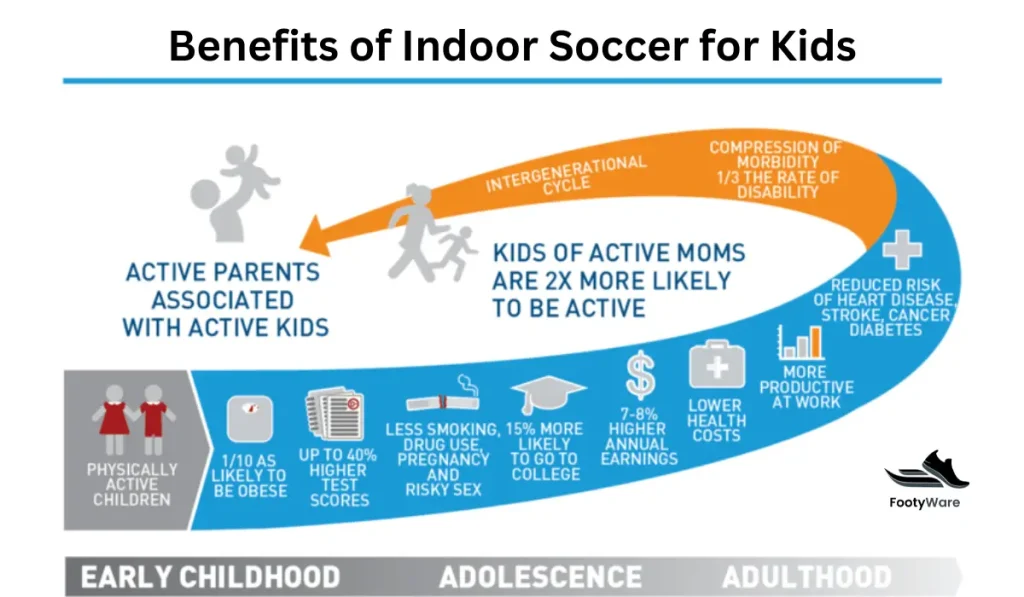
Indoor soccer offers an outstanding range of developmental benefits for children that extend far beyond the field of play. The fast-paced indoor soccer version builds fitness, socio-emotional skills, and mental awareness in your kids.
Kids gain much more than just athletic abilities while having a blast with friends they remain physically fit and they become more immune against diseases like cough etc. Sports make them socially more active and make them positive community leaders.
Indoor soccer not only makes your kids good at sports but makes them more focused on their studies too there is a study on kids that kids who play sports are more active and also sharp-minded because they’re more focused than others because of their multi-tasking and juggling both at once makes them the best.
Physical Fitness leads to Mental Fitness
The non-stop motion of indoor soccer boosts fitness and coordination in young athletes. The sport also instills healthy habits.
Healthy habits lead to a healthy mind and as a result, productivity in daily tasks increases by 60-65%, and due to physical activity like indoor soccer you burn a lot of calories in a result you like to eat healthy food like fruits, dry fruits and also healthy proteins.
Indoor Soccer Adds-up to Agility
The tight spaces and close competition of indoor soccer require ultimate agility and coordination. Frequent changes of direction back and forth. Children practice controlling their bodies in tight spaces through balance and body control by doing indoor soccer drills.
Doing indoor soccer drill your kid will outshine in his class because of an extra talent this give children more confidence and they’re also given more preference than other in the school because he represents them and in some cases, schools offer them scholarships too.
Cardiovascular Health of Your Kid
The continuous back-and-forth nature of indoor soccer provides an excellent cardiovascular workout. Kids burn calories and build stamina by playing their hearts out and develop healthy competition which makes them good at that specific activity.
It’s human nature that he wants to have a competition. This boosts long-term health. The exciting environment makes exercise enjoyable.
Children associate soccer with fun instead of fitness so make it fun for them as well as instill in them how to win or lose. Life-long lessons in the field are often memorable.
Social Interaction, Coordination, and Teamwork
Indoor soccer also enables meaningful social connections and teamwork skills. Kids learn to collaborate, communicate, and forge bonds. Through communicating they can do wonders together but that communication should be coordinated properly.
Social active children are more active because they’re confident enough to give their best and share their experience in a more practical form which make them problem solver and the skill which’s required nowadays at most is problem-solving skills.
Individually you can’t do anything but with a team, you can achieve collective and individual goals. Keep this in mind you can’t be good at everything but with the right team you can accomplish the unachievable tasks.
The same goes for a team game like indoor soccer you learn how to work collectively. So encourage your kids to take part in sports and give their best and they’ll improve day by day. Lessons learned will later provide an edge to your kids in their professional careers.
Making Lifelong Bonds: Teammates and Friendship
The small-sided indoor game allows teammates to interact more frequently. Bonds deepen through sharing a fast-paced competitive journey. Kids encourage each other through ups and downs. Lasting friendships form on and off the field.
Later they start a business or even startups with each other and you can easily imagine their bondage from early childhood and continues till their young ages making them outstanding entrepreneurs. This all starts with a team game like indoor soccer.
Teamwork and Communication for Your Kid
In the space indoor, communication and teamwork become essential. Players must coordinate positioning and pass verbally in tight spaces. Younger kids learn to organize teammates respectfully.
Listening, working together, and acknowledging contributions help achieve shared goals. These transferable teamwork skills benefit kids enormously in school, extracurricular activities, and beyond in their professional careers too.
Cognitive Development of Kids Playing Indoor Soccer
Life is very fast nowadays and we want our kids to get with the pace so that they can compete with the world at an equal level. The quick decisions and strategic thinking required in indoor soccer also provide mental benefits for kids.
The game sharpens focus, quick thinking, planning, and calculation skills.
Do you agree that these skills will also benefit him in the future or not?
These are life skills that your kid will learn on an indoor soccer field joyfully. Think of learning like this and then implementing them in real-life situations. What will be the output?
so make your child play physical sports instead of video games and encourage them to play team sports to learn managerial skills with a team and how to deal with them.
Polishes Decisions Making Skills
Indoor soccer’s quick tempo requires fast thinking and decision-making. Reacting instantly to changes on the small-sided field keeps kids mentally sharp and attentive. Processing information and executing quickly under pressure boosts mental speed.
These cognitive abilities translate to the classroom and other intellectual pursuits.
Strategic Planning in Soccer Indoors
Beyond athleticism, indoor soccer also involves strategy. The walled court demands planning passes carefully and moving effectively together as a team. Young kids learn the principles of spreading out, positioning smartly, and anticipating play.
They are finding creative ways to maximize the compact space taps into strategic thinking. These skills in analyzing practical tactics enrich kids intellectually and boost their confidence after successful implementation.
Indoor Soccer Journey with Your Child
Introducing children to indoor soccer requires selecting the right facility, tailoring the experience to age and skill level, and emphasizing fundamentals. This thoughtful foundation sets kids up for success on their soccer journey.
Always go for a structured indoor soccer facility with a proper schedule and under a professional coach because he’s the one who’ll teach your kid how to be the best on and off the field. Your child should play with his fellows and also with kids having the same skill level.
Selecting the Best Indoor Soccer Facility
Choosing the right indoor soccer venue ensures kids have safe, engaging experiences. Various factors affect this crucial decision.
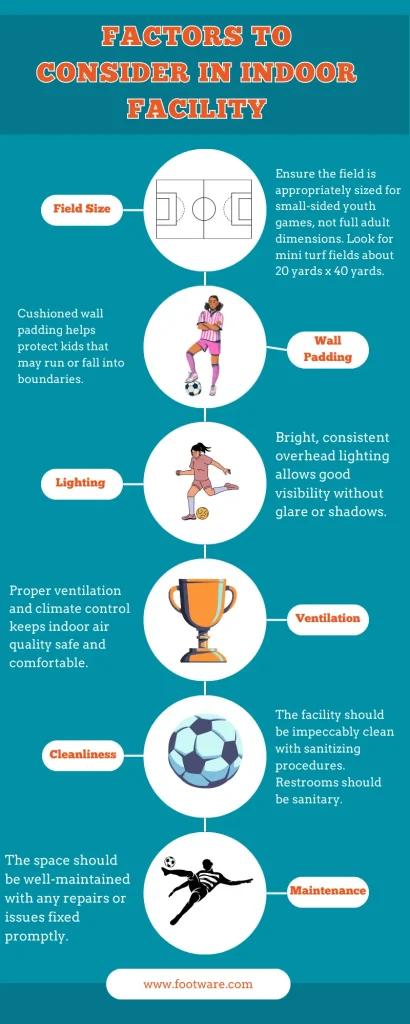
Factors to Consider in Indoor Facility
The ideal indoor facility has a welcoming community vibe with friendly staff. Cleanliness and maintenance reflect the quality of experiences. Look for sufficient scheduled programs at appropriate ages and skill levels.
Fields should be properly sized with padded walls and indoor soccer goals. The surface, lighting, and ventilation should also be of optimal level. Ultimately, the perfect indoor home nurtures your child’s passion.
Safety First: Layout and Equipment
Safety is paramount when choosing an indoor venue. Padded indoor soccer walls protect players that collide into boundaries. Portable goals minimize tip-over risks compared to anchored nets. Fields must have enough run-off room so action stays safely away from walls.
Equipment like balls should be age-appropriate and well-maintained. A clean, updated facility indicates a culture of safety. Padded poles of gaols are a plus point for under 5-year-old kids.
Training: According to age groups and Skill Level
Children have diverse needs across developmental ages. Training should adapt to toddlers, adolescents, and ages in between. It means that kids should be trained with their age groups and also with their skill level kids otherwise they won’t sync in.
Love for Indoor Soccer in Toddlers
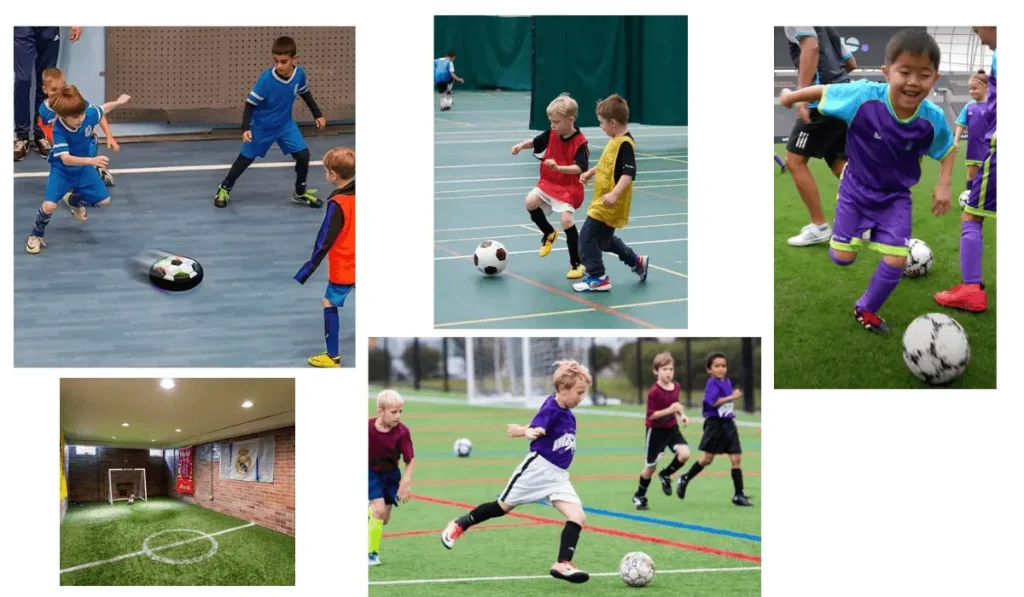
Toddler programs use playful games to introduce indoor soccer concepts. Basic movements like running, stopping, kicking, and trapping get ingrained through repetition. Low coach-to-player ratios allow individual attention.
Toddlers learn to follow instructions, take turns, and interact positively. Fun experiences nurture a lifelong passion for soccer. The most important thing you can do is watch indoor soccer with them. They’ll make ideas and then they’ll feel more attached and passionate towards indoor soccer.
Passion always leads to inspiration and inspiration makes you someone unbeatable.
Advance Indoor Soccer Drills for Kids
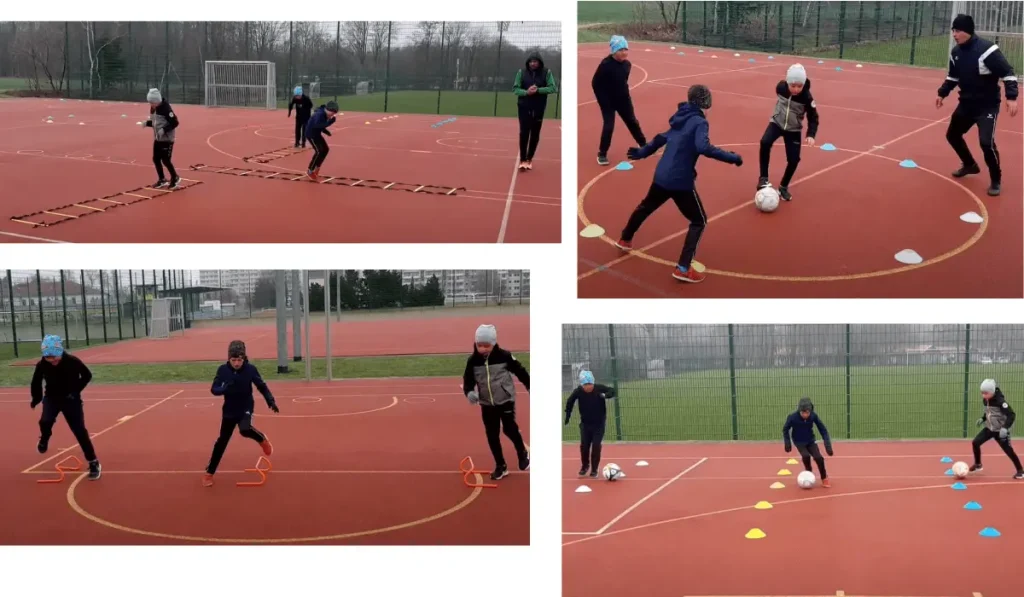
By early adolescence, most kids have developed foundational indoor soccer skills and a passion for the game. Training now evolves to sharpen tactics, fitness, and techniques.
- Fitness boot camps build core strength, power, stamina
- Plyometrics like lateral hops build explosiveness
- Footwork drills improve coordination and dribbling
- Complex passing sequences heighten vision and control
However, indoor mastery begins with proficiency in basics like:
- Dribbling
- Passing
- Shooting
- Ball control
Once ingrained through repetition, basics give the confidence to excel.
Fun, and engaging indoor soccer drills develop fundamentals while keeping kids motivated.
- Shark Attack Dribbling – dribble around cones while avoiding “sharks”
- Treasure Hunt Shooting – dribble through cones and shoot at a target
- Pass Carousel – one-touch passes around the perimeter
- Monkey in the Middle – keep away from passing game
- Up-Back-Through – combine dribbling, passing, shooting
Tactical drills build skills for game situations.
- Defensive stand drills
- Attacking build-up play
- Scrimmage develops intuitive skills
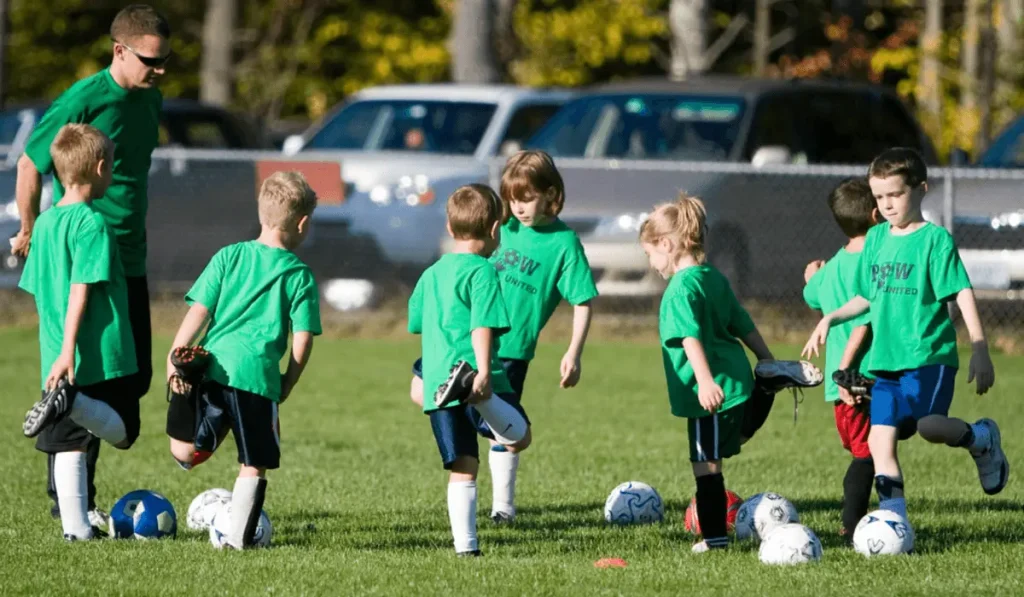
The Art of Dribbling a soccer ball
Dribbling unlocks indoor dominance, from basic control to creative moves. Toddlers first learn to move with the ball forward with the inside and outside of their feet. Dribbling through cones builds coordination with their mind and muscles.
Older kids perfect acceleration, changes of pace and direction, fakes, and body feints to beat defenders. Master dribblers carry the ball effortlessly.
Ultimate Passing and Kicking in Indoor Arena
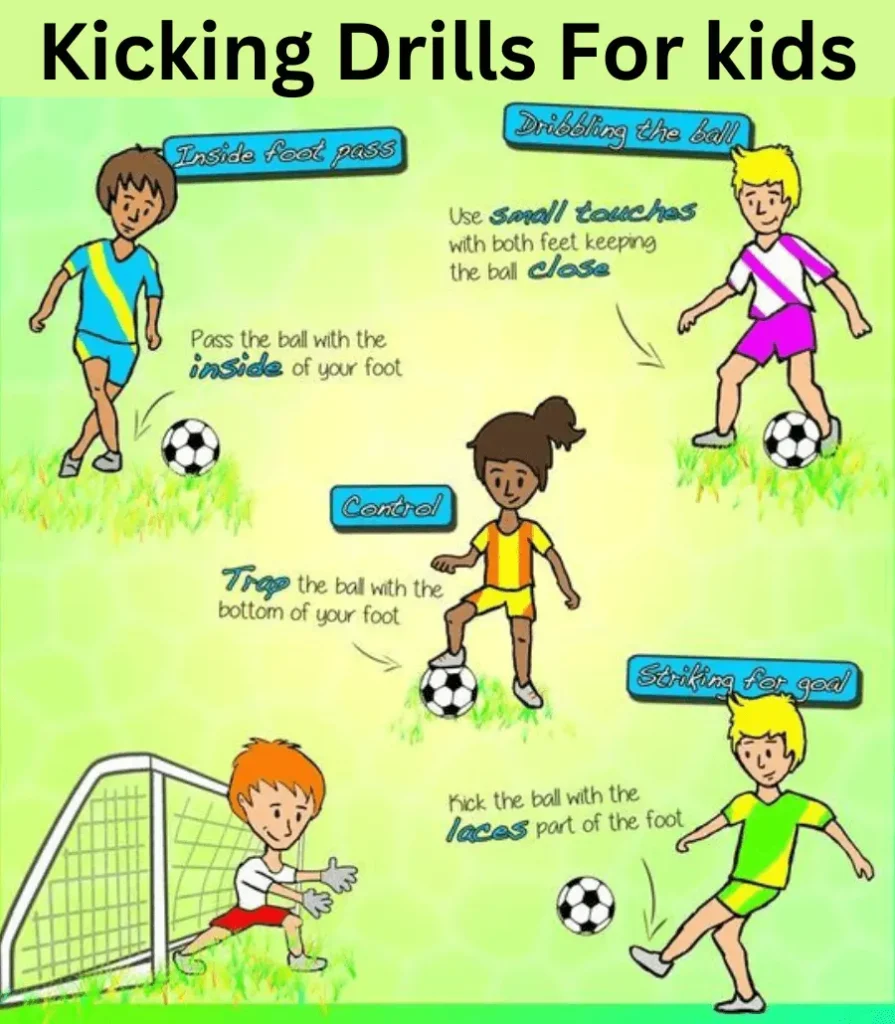
The output of passing is outrageous goals. Short accurate passes are the lifeblood of indoor soccer in tight spaces. Kids learn proper passing form and weight for smoothly receiving the ball with confidence.
Empower players to score by perfecting shooting techniques. Placement and fierce shooting focus on accuracy. Volleys and half-volleys add something entertaining to watch and also score outrageous goals from out of the box.
Cultivating a Positive and Enriching Learning Environment
The indoor soccer environment hugely impacts children’s experiences. Coaches, teammates, and parents must foster inclusive, nurturing environments where kids thrive.
Inspiring Coaches: More Than Just Soccer Gurus
Great coaches not only teach soccer but also life lessons. Their guidance enriches kids on and off the field.
Warming Up and Cooling Down: Keys to Injury-Free Play
Dynamic warm-ups and gentle cooldowns prevent strains and fatigue-related mishaps. Make them fun routines kids adopt for life.
Gear Up: Equipping Your Soccer Star for Success
Proper indoor soccer gear like high-quality cleats enhances indoor play and prevents injuries. Hygiene and facility cleanliness also minimize health risks.
Elevating the Game: Exciting Drills and Activities
Inventive practices and competitions take kids’ indoor soccer to the next level with skills and smiles. Vary activities to nurture diverse athletic and life skills.
Vital Role of Parents in Indoor Soccer for Kids
Parents profoundly influence a child’s youth sports experience. While indoor soccer unfolds between sidelines, parents’ emotional support and life guidance shape kids’ capability to thrive in sports as well as in academics
- Providing Encouragement – Parents can ignite a passion for indoor soccer by praising effort, attending games to cheer kids on, and sharing inspirational stories related to indoor soccer players. Positivity and emotional support from parents uplift kids’ confidence.
- Logistics and Commitment – Parents facilitate indoor soccer by finding suitable indoor soccer facilities, arranging transportation, purchasing equipment for their kids, and making soccer a consistent priority despite busy schedules. This commitment enables kids to participate and follow a healthy routine.
- Balancing Priorities – Parents help kids balance indoor soccer with academics and other activities through open communication, time management, and reinforcing the importance of school as well as sports. Kids learn to juggle both indoor soccer and academics which make them good at multi-tasking.
- Safety Precautions – Parents can enforce proper safety gear, hygiene, proper stretching, and monitoring exertion/hydration levels. Preventing injuries preserves kids’ health and enjoyment of the sport. Make sports enjoyable rather than hectic for them.
- Life Lessons – Parents reinforce coaches’ lessons about sportsmanship, teamwork, and handling both success and disappointment with emotional maturity. This instills character kids carry beyond soccer. Lessons learned there remain part of their life forever.
- Skills Training at Home – Parents supplement team practices with backyard soccer play and skills training. This additional repetition accelerates development and makes children more and more inclined towards healthy activity.
- Modeling Conduct – How parents demonstrate sideline behavior establishes expectations. Kids mirror parents’ examples of positivity, respect for opponents and officials, self-control, and gratitude.
Conclusion of Soccer for Kids Indoor – Enduring Legacy
Indoor soccer transcends the thrill of the final whistle and the gleam of trophies. It’s a transformative journey that sows seeds of physical prowess, social wisdom, and mental resilience, nurturing young champions both on and off the court.
Think of every deft dribble through cones not just as a soccer skill, but as a lesson in coordination and focus that spills over into the classroom. Imagine the high fives and cheers after a winning goal not just as victory, but as sportsmanship forged in the heat of competition – a foundation for lasting friendships and collaborative spirit.
The benefits are backed by concrete evidence. A 2022 study in Sports Pediatrics revealed that young futsal players boasted 28% higher cardiovascular fitness than their peers. A Sports Psychology Journal analysis showed that a staggering 92% of kids forged lifelong friendships through indoor soccer.
But the impact extends far beyond statistics. Every stretch before warm-ups cultivates perseverance, every pass up the board hones communication skills, and every encouraging word from a coach sows the seeds of wisdom and resilience. Indoor soccer becomes a classroom of life, where entities like Sports Blast or United Futsal provide the vibrant arenas for these lessons to unfold.
For parents, it’s not just the pride of watching raw talent blossom into polished skills. It’s the realization that every tackle teaches determination, every goal fosters self-confidence, and every shared victory builds unbreakable bonds.
So, embrace the rise of indoor soccer, not just for the trophies and triumphs, but for the enduring legacy it leaves behind. Let your kids tumble onto turf fields, chase dreams under bright lights, and discover a world where bright futures are crafted with every pass, every dribble, every kick. The journey won’t just reveal new talents, it will empower young lives.
